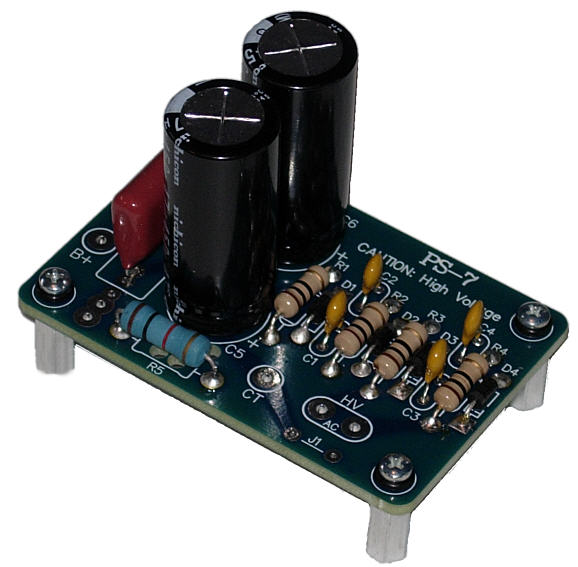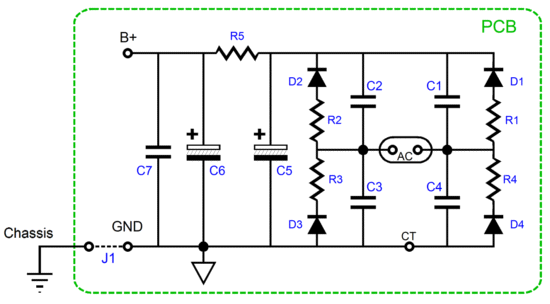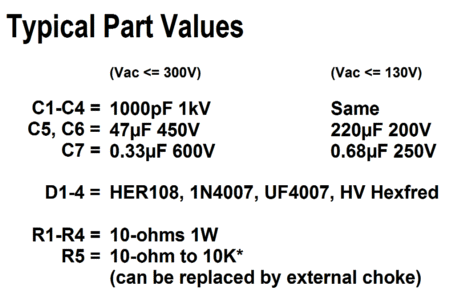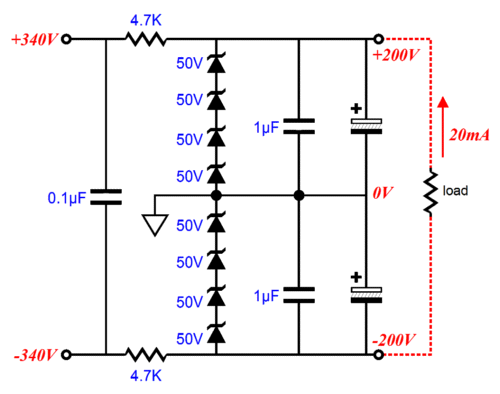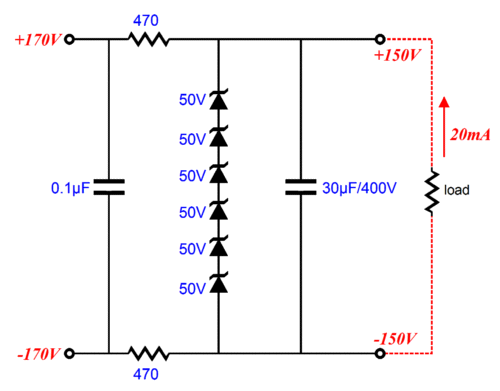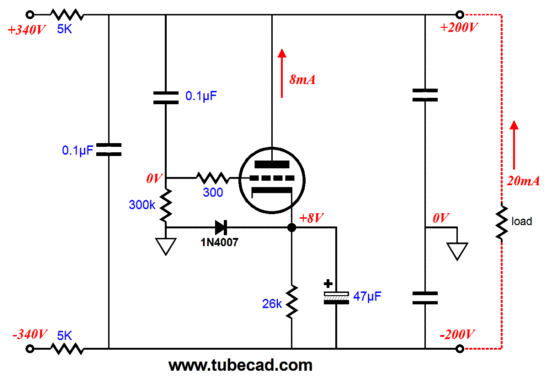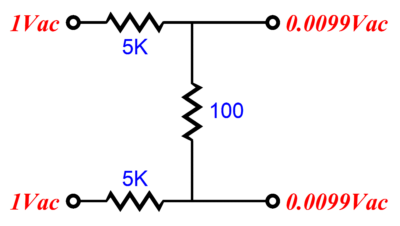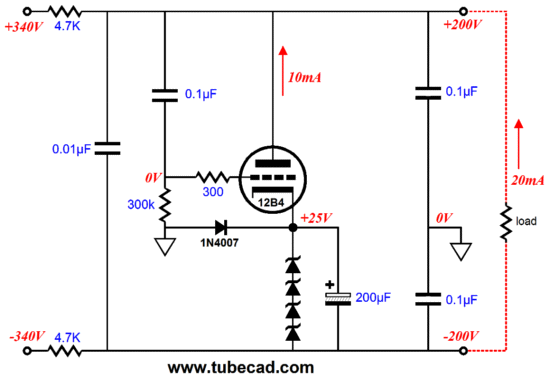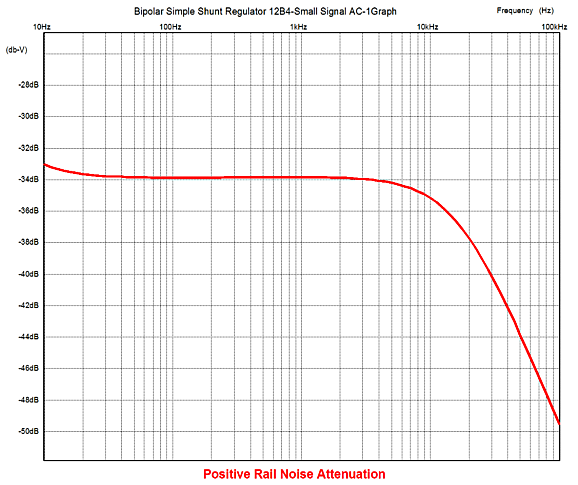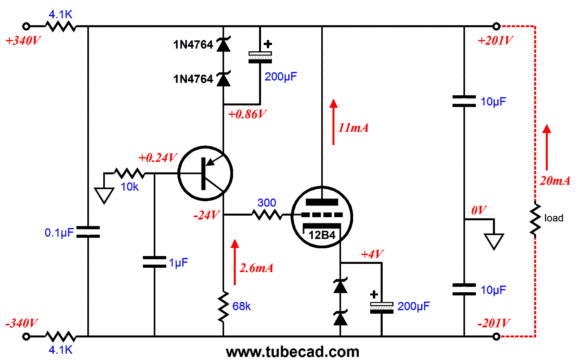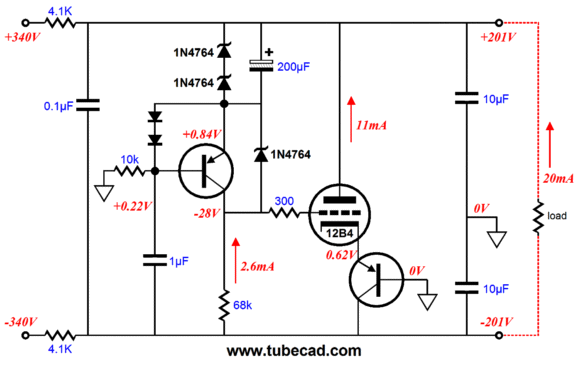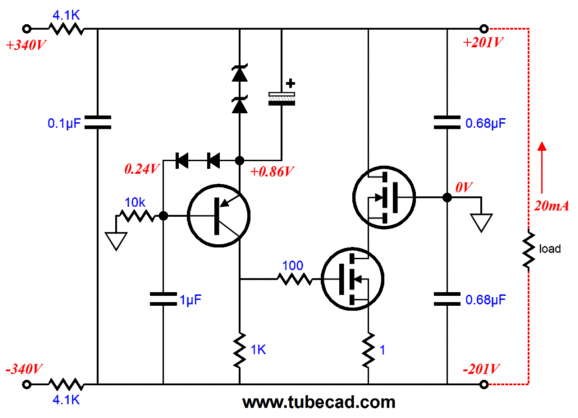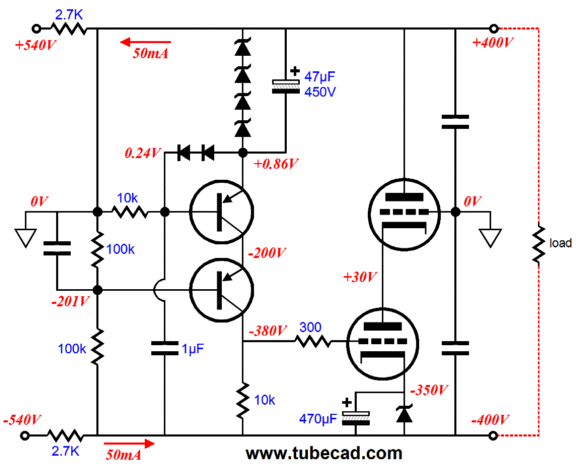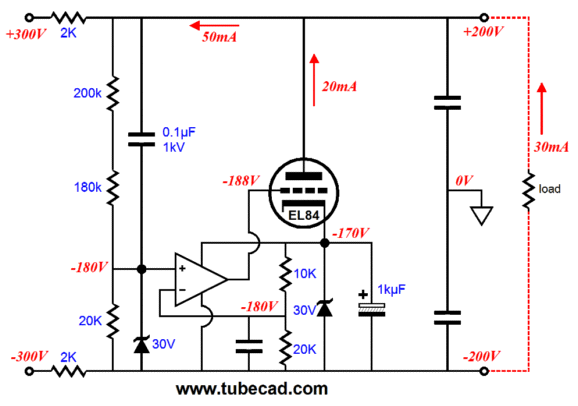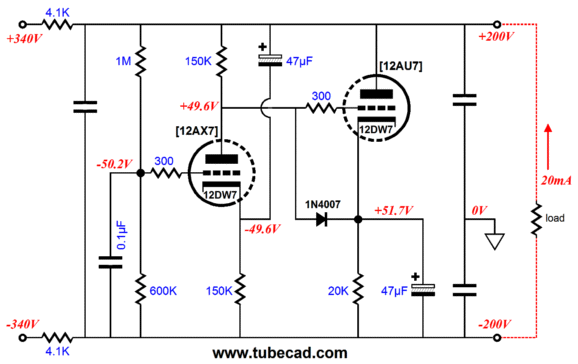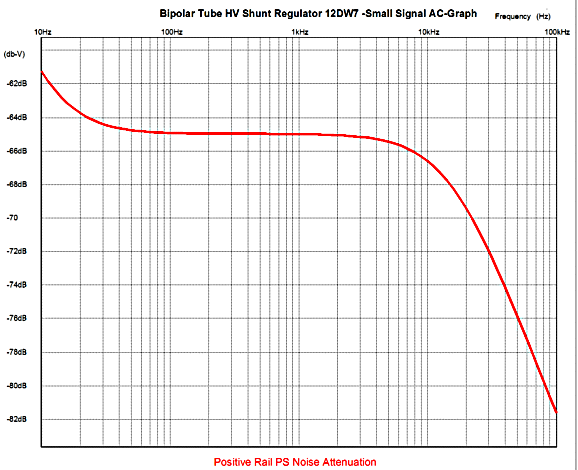| John Broskie's Guide to Tube Circuit Analysis & Design |
Post 209 07 August 2011
PS-7 High-Voltage Power Supply
The circuit is extremely simple: four rectifiers, five resistors, and seven capacitors. The PS-7 can also be used with either non-center-tapped power transformer or with a center-tapped transformer: just attach the center tap transformer lead and leave rectifiers D3 & D4, resistors R3 & R4, and capacitors C3 & C4 off the PCB. Capacitors C5, C6, C7 and resistor R5 define a simple RC filter that helps smooth away ripple. Resistor R5 can be replaced by an external choke (inductor). The lower the DC output voltage, the bigger capacitors C5 & C6 can be. For example, if we lower the secondary voltage to below 130Vac, then we can use 220µF/200V capacitors, which offer four times more capacitance over the 450V capacitors. And if we lower the secondary voltage to below 36Vac, then we can use 1kµF/63V capacitors, which offer twenty times more capacitance over the 450V capacitors. If the current draw remains constant across these three voltage options, the ripple will fall with each increase in capacitance. Who would need such this high-voltage power supply? I do, for one, which is why I designed the PCB. I found myself often needed a small power supply to add to existing electronic gear or new projects, but I hated having to point-to-point all 18 parts on a terminal strip, even though I am good at this task. To be honest, I am quite surprised by the popularity of the PS-9 kit, which takes the unused 5Vac winding and voltage doubles it, so that it can power 12V tube heaters. Maybe the same will happen with the PS-7. By the way, if you have built similar power supplies and have been disappointed with the results, I will bet that you used the ubiquitous 1N4007 and that you didn't place a 10-ohm resistor in series with each rectifier or a bypass capacitor. The HER108 is a superfast rectifier that sounds surprisingly good. The PS-7 power supply kit is available now at the GlassWare Yahoo store, with the choice of three capacitor voltages, 47µF/450V, 220µF/200V, and 1kµF/63V.
Bipolar Shunting Regulators
Such a simple power supply works quite well, considering how noisy and high-ohmage high-voltage zeners can be. (I have used such a zener-based bipolar shunt regulator many times and I have seldom felt the need to upgrade to something better.) The key point to remember with any shunt regulator circuit is that the shunting device, be ita triode or a transistor or a zener string, is most burdoned when the regulator is unloaded. Thus, when specifying the zener wattage, be sure to do the calaculations for the worstcase scenario, wherein there is no external load current. If the rail voltages are low enough, the following variation can be used.
In the above circuit, one high-quality film capacitor is used in place of the two electrolytic and the two small-valued film capacitors. Note how none of the parts attach to ground. Why not? Since our hybrid Op-Amp runs in pure class-A, the positive and negative rails should see the same average current draw, which means that both rails should track each other in voltage and we want these two rails to hold the same amount of power-supply noise, but out of phase with each other, which the singe zener string and single capacitor help achieve. Because the zener string not only establishes the fixed rail voltage but also limits the maximum volatage across the 30µF capacitor, we need not worry too much about the raw DC voltage; in other words, since the zeners protect the capacitor, the raw differential voltage can safely exceed the capacitor's rated value, say 500Vdc with a 400V capacitor. Okay, the zener string is interesting, but where do the tubes enter pictures? Before leaving the zener behind, let's not forget that the zener provides a fixed output voltage, which can often be desirable—indeed, vital. But with our high-voltage Op-Amps and other tube-based audio circuits that usea bipolar power supply, we enjoy a great deal more latitude, as it little matters whether the rail voltages vary by +/-20Vdc. What is essential, however, is that the rails be as noise-free as possible. The following simple shunt regulator uses but a single triode to actively reduce power-supply noise, but it provides no DC voltage regulation.
Tube-Based Bipolar Shunt Regulators
If the triode offered infinite transconductance, the power supply rails would be noise-free. Alas, no triode is bestowed with any thing close to infinite transconductance. If we are lucky, we might get 10mA/V, which means that at its best, the triode would effectively act as if it were a 100-ohm resistor, as 1/gm equals the triode's effective resistance in thew shunt regulator, as the grid attaches to the palte. In other words, such a triode would voltage divide the AC noise by the ratio between it and the two 5k resistor in series, as the following circuit shows.
Okay, let's look at an actual circuit that uses readily available parts. The 12B4 is a sturdy little power triode that can withstand an amazingly high cathode-to-plate voltage (1kVpk) and whose plate can dissipate up to 5.5W. The zener string is made up of four (or more) zeners that establish a break voltage of 225Vdc, which the shunt regulator will use as its internal voltage reference.
How well does this regulator perform? In SPICE, the following graph shows the power supply rail's ability to shunt away the raw rectifier noise at the other side of the 4.7k series resistor. It's a bit hard to make out, but the attenuation is about -34dB at 1kHz. Not bad. Not bad at all. Of course, slapping a large-valued capacitor in parallel with triode circuit would help, but the big limitation is relatively weak transconductance offered by triodes (and pentodes).
The obvious workaround is the amplify the signals presented to the triode's grid, which would effectively amplify the tube's transconductance. In the circuit below, we see a hybrid affair with the transistor greatly amplifying the power supply rail noise signal before passing it on to the triode.
One obvious problem with this circuit is that the PNP transistor must have a voltage rating over 700V, as at startup, when the triode is cold and not conducting, the transformer will see the full differential raw rail voltages (the bypass capacitor across the transistor's zener string must first charge up before the zener string latches on its break voltage). In addition, the transistor's base will see a huge negative voltage (relative to its emitter) at startup, as the 1µF capacitor must also charge up. The following circuit addresses the PNP transistor's the problem of its relatively low emitter-to-collector voltage and eliminates the triode's zener string (and its bypass capacitor). Note how this second transitor will—worstcase—see only 340Vdc, not the full 680Vdc differential that the transistor on the left will see.
The extra 1N4764 placed in parallel with the PNP transistor limits the maximum voltage across the transistor to 100V; the two diodes (1N4001) also protect the amplifying transistor, as they prevent the transistor's base from ever being more than 1.4V more negative than its emitter, which is critical, as a large over voltage can blow the device and even a small over voltage can result in permanent damage to the transistor's noise factor. Yes, I know that the tube is surrounded by so many icky solid-state devices that it is hard to see how it works. (One problem with building any high voltage solid-state circuit is the necessary inclusion of many protection devices, as solid-state and high voltage do not mix well together. Indeed, if I had another five minutes, I could probably come up additional protection devices, which may still prove insufficient to create a robust hybrid shunt regulator.) Of course, we could go all-solid-state, as the following circuit illustrates.
The two high-voltage MOSFETs are in cascode, which may not be neccesary, as 1200V MOSFETs are readily available. Now, if you had encountered the above schematic elsewhere, the first thing you should do, in your mid, is replace the MOSFETs with triodes. I always do and I end up seeing the following circuit.
Note the rail voltages, 400Vdc, not 200Vdc. Although not shown, the hidden problem is that the top and bottom triodes require seperate heater windings or DC power supplies, so as not to exceed the the triode's cathode-to-heater voltage limit. Or, we could use an OpAmp to control the tube's current conduction.
The OpAmp uses the zener at the tube's cathode to both develop its DC voltage power supply and to provide a useful voltage reference. The OpAmp compares the DC voltage at its positive to the DC voltage at its negative input. It then uses it astronomically huge DC gain to bring the rail voltage in line. So too, the OpAmp compares the differential noise signal on the rails and sends a countervailing correction signal to the triode's grid. The EL84 was selected because it does not need a hugely negative grid voltage. If a less efficient tube were used, such as a 300B for example, then an additional zener would have to placed in series atop the existing zener.
At Last, the Beginning
The following all-tube, bipolar, shunt regulator uses a 12DW7, a dissimilar tube that holds 12AX7 and 12AU7 triodes. The 12AU7 section does all the heavy current swinging, while the 12AX7 provides all the voltage amplification to drive the 12AU7 triode.
Note where the capacitors that attach to the 12AX7's grid and cathode terminate. Do they appear upside down? Shouldn't the grid see the positive rail noise and the cathode see the negative rail noise? No. We do not want the 12AX7 triode to invert the phase of the differential input signal created by the power-supply noise on both rails. Thus, the cathode must attach to the positive rail, while the grid couples to the negative rail. The non-inverting signal leaving the 12AX7 triode drives the 12AU7, which will vary it conduction in response to the signal, thereby countering the power-supply noise on the rails far beyond what a single 12AU7 triode could ever hope of accomplishing. The two-resistor voltage divider at the 12AX7's grid establishes the voltage relationships between triodes. Note how the 12AX7's cathode is at -50Vdc, while the 12AU7's cathode is at 52Vdc, which allows us to attach the 12DW7's heater to power supply that is at ground level, as each triode only sees a 50V cathode-to-heater differential. The non-inverting signal leaving the 12AX7 triode drives the 12AU7, which will vary it conduction in response to the signal, thereby countering the power-supply noise on the rails far beyond what a single 12AU7 triode could ever hope of accomplishing. The two-resistor voltage divider at the 12AX7's grid establishes the set voltage relationships between triodes. Note how the 12AX7's cathode is at -50Vdc, while the 12AU7's cathode is at 52Vdc, which allows us to attach the 12DW7's heater to power supply that is at ground level, as each triode only sees a 50V cathode-to-heater differential. What is that lone 1N4007 rectifier doing in the circuit? My inclusion of this safety diode just drives many tube-masters crazy. Yet, it is essential. Why? Imagine that the 12DW7 is room-temperature cold, which means that none of its cathodes are conducting. At startup, the 12AU7 triode will have its cathode at -340Vdc, while its grid will be at +340Vdc, a 680Vdc voltage differential! I have never seen a 12Dw7 fly out of its socket, but with such a voltage differential, you just may. (I know that many readers worry a great deal about what their local tube guru says and believes or they just never see the need to add any solid-state device to a tube circuit, so they will leave the diode out. If you so insist, please send me a picture of the hole in your ceiling.) With the diode in place, at startup, the diode will conduct, which will place the 150k and 20k resistors in series, so the 12AU7's grid can never be more than 0.7Vdc more positive than its cathode. Once the regulator is hot and up and running, the diode will be reversed biased and it will cease to conduct, effectively dropping out of the circuit. So, just how well does this all-tube regulator perform? Once again, SPICE comes to the rescue. The following graph shows that this bipolar shunt regulator is a stellar performer, as the attenuation of the raw power-supply noise is about -65dB at 1KHz. For example, 1Vpk of power-supply noise would reduce to less than 1mVpk at the positive (and negative ) rail's output terminal. Not bad.
Okay, what's not to like about this circuit? Well, this regulator scrubs away AC power-supply noise, but it does not establish two fixed power supply rail voltages. If we replace the 12AU7 triode's cathode resistor with a zener string (252V), then the regulator would strive to maintain fixed rail voltages. I would not travel down this path, as we seldom need precise rail voltages and I never want the 12AU7 triode to overdriven or cut off in pursuit of an unobtainable goal. With the load attached, the 12AU7 need only draw 12mA; with no external load attached, however, the triode will have to conduct 32mA to maintain the 200V rail voltages. In contrast, with the cathode resistor in place and no external load, the 12AU7 will only increase conduction to 17mA, but the rail voltages will climb to 264V. Okay, let's imagine that we experience wall-voltage brown-out of 10%, so the raw voltage feeding the regulator falls to +/-306Vdc, which will cause the rail voltages to fall to +/-180Vdc. In contrast, with the zener string in place, the rail voltages will fall less than 2V, as the 12AU7 reduces its conduction to 5mA. At the other extreme, where we suffer an over-voltage of 10% and we use a zener string, the raw voltage feeding the regulator climbs to +/-374Vdc, which will cause the rail voltages to build up to +/-202Vdc and the 12AU7's conduction to rises to 20.5mA; and without the external load, the 12AU7 will conduct 40mA, which will exceed its plate dissipation limit. This was a worthwhile examination, as it reveals that the greatest danger in using the zener string is the no-load situation. Thus, if there is no chance that the regulator will be asked to function without a load current, use the zener string, as 1% DC regulation is amazingly good for an all-tube regulator. Before anyone asks... No, I do not plan on creating a PCB for this circuit. Well, at least not this year.
Next Time
//JRB |
I know that some readers wish to avoid Patreon, so here is a PayPal button instead. Thanks.
John Broskie
And
High-quality, double-sided, extra thick, 2-oz traces, plated-through holes, dual sets of resistor pads and pads for two coupling capacitors. Stereo and mono, octal and 9-pin printed circuit boards available.
Designed by John Broskie & Made in USA Aikido PCBs for as little as $24 http://glass-ware.stores.yahoo.net/
The Tube CAD Journal's first companion program, TCJ Filter Design lets you design a filter or crossover (passive, OpAmp or tube) without having to check out thick textbooks from the library and without having to breakout the scientific calculator. This program's goal is to provide a quick and easy display not only of the frequency response, but also of the resistor and capacitor values for a passive and active filters and crossovers. TCJ Filter Design is easy to use, but not lightweight, holding over 60 different filter topologies and up to four filter alignments: While the program’s main concern is active filters, solid-state and tube, it also does passive filters. In fact, it can be used to calculate passive crossovers for use with speakers by entering 8 ohms as the terminating resistance. Click on the image below to see the full screen capture. Tube crossovers are a major part of this program; both buffered and un-buffered tube based filters along with mono-polar and bipolar power supply topologies are covered. Available on a CD-ROM and a downloadable version (4 Megabytes). Download or CD ROM
|
|||
| www.tubecad.com Copyright © 1999-2011 GlassWare All Rights Reserved |

